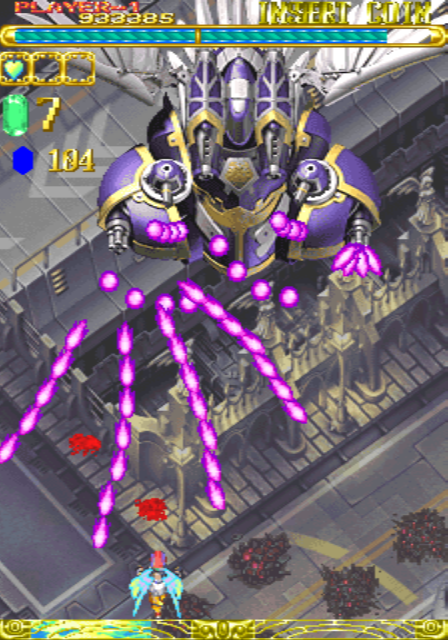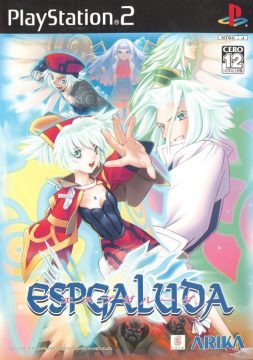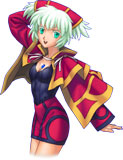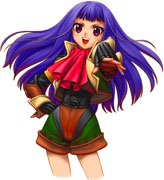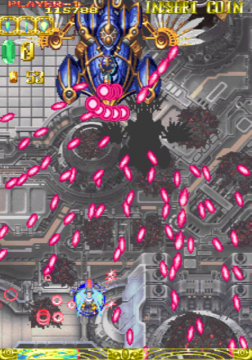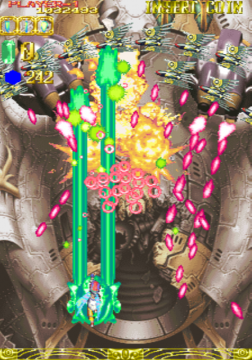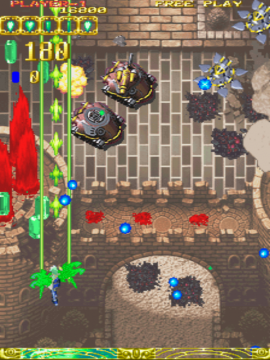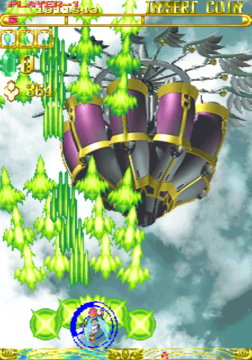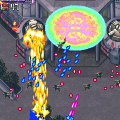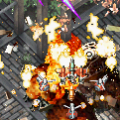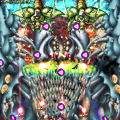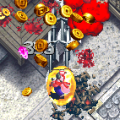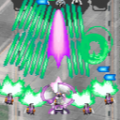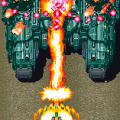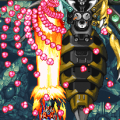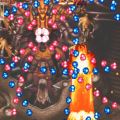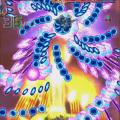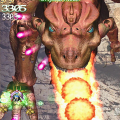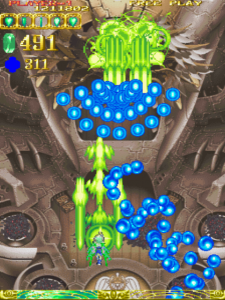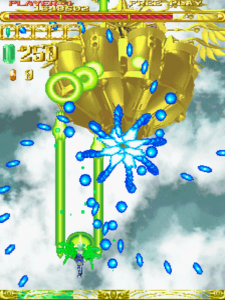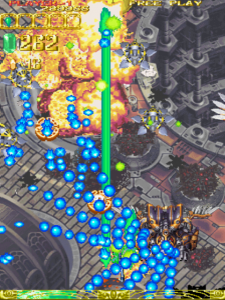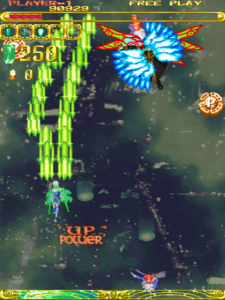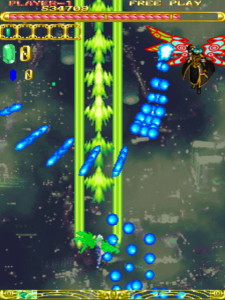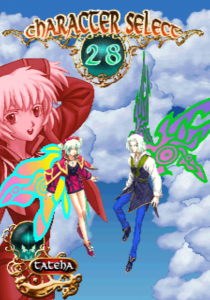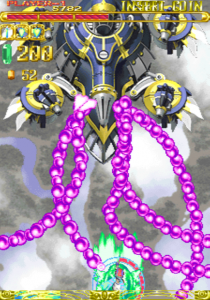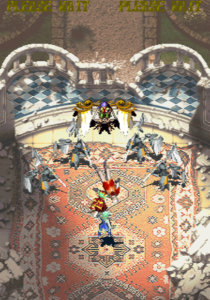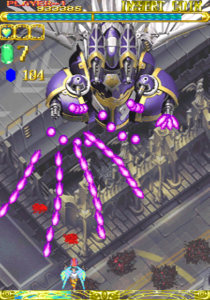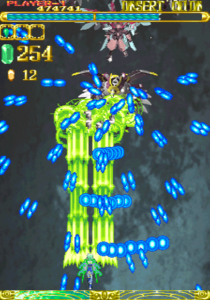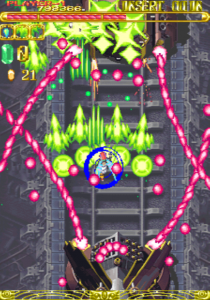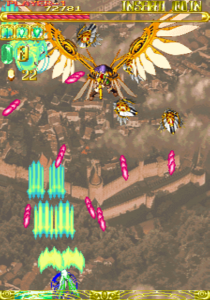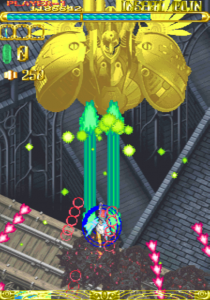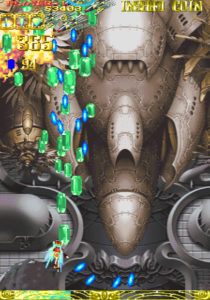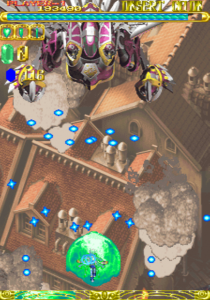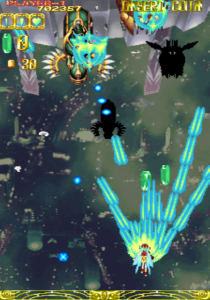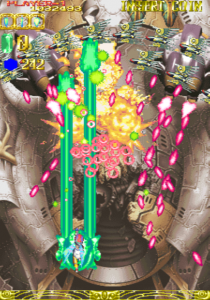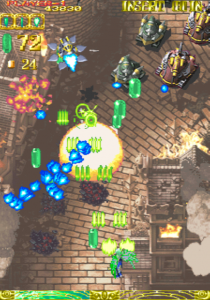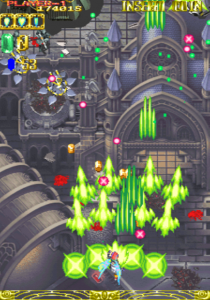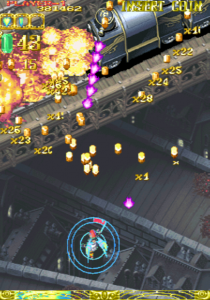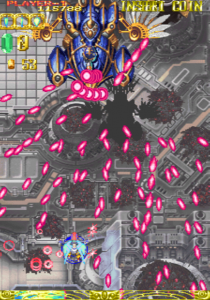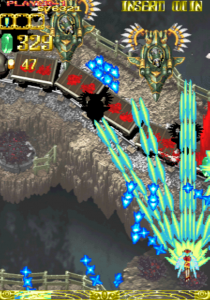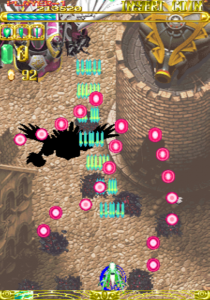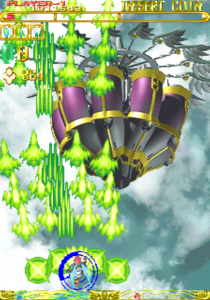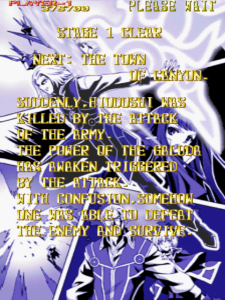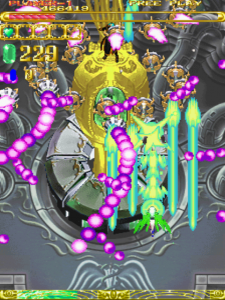- Espgaluda
- Espgaluda II
Cave’s 1998 psychic-themed shoot-em-up ESP Ra.de was well-received in arcades and remains fondly regarded (infinite boss milking excepted) today: regular requests for a followup have flowed from the fandom, but so far nothing has come of it…well, maybe it’s more appropriate to just say that a direct sequel hasn’t happened. Five years after Ra.de‘s appearance, Cave finally announced a second scrolling shooter featuring “flying human” player avatars (as opposed to the usual airplanes or spaceships), and even released preview artwork of the cast outfitted with neon-colored “wings” similar to those sported by ESP Ra.de‘s last boss – as it turns out, though, the similarities pretty much ended there. As sure a success as Ra.de 2 would have been, Cave was actually making a carefully-calculated departure from convention with this project: its results, one way or the other, would influence the company’s direction profoundly.
Nomenclature notwithstanding, for Espgaluda (unlike Ra.de the “ESP” isn’t capitalized, though the “L” sometimes is) Cave decided to completely ditch the setting, cast, weaponry and scoring system of its “spiritual predecessor”. Taking their place was a vague concept for a “softer” shooter aimed at a general audience, a deliberate and drastic shift in tone from the merciless, industrial style of DoDonPachi Dai-Ou-Jou and Ketsui: unsure how to best put this idea into practice, Cave once considered borrowing the Psychic Force license from Taito to give the new game a bit of brand recognition. In the end, director Tsuneki Ikeda (previously the lead programmer for Ra.de) split the difference, hiring Tsukasa Kado, the character designer and artist of Psychic Force (as well as Border Down and Arcana Heart, among others), to come up with something new: the result, design-wise, might be broadly classified as “steampunk” but is most specifically akin to Studio Ghibli’s Laputa (aka Castle in the Sky), melding elaborate, archaic technology with a touch of ethereal mysticism.
Set in the small, normally-peaceful kingdom of Shinra, whose queen inherits supernatural powers from generation to generation, things have (of course) taken a tragic turn. Overcome by ambition due to a series of recent and rapid advances in alchemy, Jakou, the king, has become obsessed with fully exploiting his wife’s gift, to the point where he subjects his two young offspring to a super-soldier program, “Project Espgaluda” (“Galuda” presumably a mistranslation of Garuda, avian mount of the Hindu god Vishnu). The horrified queen reacts by sealing herself and her essence away within an array of “spirit gems”, but Jakou would not be thwarted – before long his alchemists have developed a “spirit engine” capable of harnessing the stones’ latent energy, and with this newfound power in hand he sets off to conquer the surrounding nations.
Project Espgaluda, however, hits a crippling snag – Hiodoshi, an elderly alchemist whose conscience ultimately leads him to turn against the program, takes the king’s children into his arms and runs away, eventually settling far from the palace to give them as “normal” an upbringing as he can. Some years later, Jakou’s forces finally track the little family down – Hiodoshi refuses to surrender his wards, who can only watch, horrified, as the soldiers mercilessly slaughter him. This tragedy stirs a latent power in the siblings – long-dormant luminescent wings suddenly manifest themselves, and the assailants are wiped out in an instant. The awakened pair then take flight, but instead of making their escape are led deeper into a hostile Shinra by a force neither one understands.
Characters
Ageha
The elder of the two selectable “Galudas”, he’s usually friendly and cooperative but tends to shut everything else out once something grabs him emotionally, especially in matters concerning his family. The quicker mover, he also boasts the stronger “laser” weapon; his “normal” shots can be “bent” to either side as he moves for a bit of extra coverage. His name comes from the Japanese for the Papilionidae family of butterflies.
Tateha
Ageha’s junior by two years, she has a more consistently cheerful disposition than her brother, whom she adores unconditionally. Lacks Ageha’s raw speed and power, but makes up for it with tighter precision when weaving through thick enemy patterns and a wider shot spread which can easily clear out crowds of drones. Her name is derived from the Nymphalidae butterfly family.
Seseri
Jakou’s youngest daughter and a recurring boss fight. She was not mothered by the queen and thus never subjected to Project Espgaluda, but her father’s undying obsession with Ageha and Tateha leaves her jealous and resentful of them both. Eventually she volunteers to spearhead the military’s search effort in a desperate attempt to gain his favor; after you blast her out of the sky in the first stage she returns for a rematch near the end, outfitted with bandages, mechanical parts, and much nastier attacks. While not playable, she’s unquestionably the series’ most popular character. Named for the Hesperiidae butterfly family.
Basic moving and shooting in Espgaluda should feel familiar to anyone who’s played a Cave game before: tapping the “fire” button uses your character’s “normal” attack, while holding it down “focuses” the shots into a more powerful straight-ahead laser stream (officially called the “rapier”) and slows his or her movement speed. Occasionally you’ll encounter standard “power up” items which boost the potency of your shots; losing a life ratchets you back down, but some of your previously-collected enhancements will be released and can be reclaimed to soften the blow a bit. The “guard barrier” (your limited-use “bomb” weapon), is the gameplay’s lone “direct” link to ESP Ra.de. A quick button press activates a brief shield to save you from a hit, but its effect can be lengthened and amplified by holding the button down, at the cost of additional “bomb meter”: a powerful frontal beam is fired once you let go. Refill items for your “bomb meter” exist, but are quite rare, so use this ability wisely – the only other way to get meter back is to lose a life.
Now, though, we come to Espgaluda‘s definitive mechanic, the “kakusei” (“awakening”) ability. As you blast enemies they drop emerald-like “spirit gems”, which are collected automatically – they aren’t worth many points, but destroying your targets quickly makes them surrender a bit extra, and any unfriendly bullets that hit your “guard barrier” are also turned into gems. Once you have some glittery green stuff in stock (up to 500 maximum), pressing the “kakusei” button will shift your character into “awakened” mode, which drastically changes several things:
1) Your character switches gender, from male to female or vice-versa (and also sports a different outfit, somehow). Why? For variety’s sake, and “visual impact”, according to the designers. Anyway, moving on…
2) The power level and properties of your “normal” and “laser” attacks are altered: in Ageha’s case the laser becomes more potent but his main shot grows weaker, while the opposite goes for Tateha.
3) If you are hit by an enemy bullet, half of your “bomb energy” meter will be expended on an “auto-bomb” which will prevent you from dying, assuming you have ample energy available.
4) Most importantly, the movement speed of both your enemies and their shots (which take on a distinctive purplish color) slows down drastically: this obviously makes safely navigating the screen much easier. Look out, though: your “spirit gem” stock drains constantly during “awakening”, and drops further still whenever you shoot down an enemy in this state. If you don’t press the “kakusei” button again to switch back into “normal” mode before your gems run out, the bad guys’ firepower turns bright red and starts moving faster than usual: this is called “overmode”, and you’ll definitely want to avoid it under most circumstances.
That’s right – it took a puzzlingly long time to happen, but a scrolling shooter has finally adopted the “bullet-time” slo-mo mechanic popularized by The Matrix and Max Payne. This is more than just a trendy follow-the-leader gimmick, though, as this ability can be implemented in different ways, and it’s up to the player to decide how to best take advantage of it. Less-confident comers, for instance, can save their gems for any particular spots that give them trouble; though switching in and out of kakusei too frequently will drain one’s gem stock in the blink of an eye (thus preventing over-abuse), smart and timely invocation of “awakening” mode’s slower-moving hazards (and auto-bomb) can easily make the difference between continued progress and an abrupt Game Over.
For shooter veterans, however, “kakusei” mode is all about THE GOLD.
You see, there’s a nifty facet of the “awakening” technique that hasn’t been covered yet: while “awakened”, whenever you shoot down an enemy, all of the onscreen bullets it’s released are canceled out and transformed into shiny gold pieces (which, like spirit gems, are auto-collected). This handy trick not only helps to clear away valuable screen space, but serves as your main source of points; the exact value of each nugget you earn is dependent on two things. First, each ingot’s “base” value is determined by how much gold you’ve collected in total: the more you’ve got, the more valuable it becomes. Your “gold counter” maxes out at 1,000 but drains during boss fights and is cut in half when you die, so keep that stock as high as possible.
The second factor is how much gold you can snap up in one go: the longer you can drag out a single “awakening” and the more gold you can acquire while there, the higher this value climbs, up to 100 times the current base. For example, kill an enemy which has shot 20 bullets onto the screen, and the resulting gold’s worth will be multiplied up to “x20” – stay “awakened” and kill another baddie that’s put out 15 bullets, and the value will now be “x35”, and so on up to “x100”). Once you change back to “normal” mode this multiplier resets, so to mop up maximum rewards you’ll want to let loose during profitable stretches packed with heavily-armed adversaries: even smaller fare can be worth it, though, if you allow them to unload a few rounds before delivering the coup de grace. Get on a decent roll and even observers who have never seen Espgaluda before will probably be impressed by the huge, flashing numbers that pop up en masse to celebrate a big pickup.
Scoring fiends will also want to ditch their gems and cheat death to take advantage of “overmode”. If you can last for awhile in this hazardous condition, you’ll notice successively-larger “ring” indicators slowly forming around your character – stop shooting and they’ll grow more quickly. These represent your “over level”: the higher it goes the faster those nasty red bullets move, but once you’ve switched back to “normal” mode enemies cough up more gems than before. This bit of daredevilry can considerably increase the game’s overall payoff for those willing to exploit it, but dying resets your “over level” to square one, so be careful.
At this point you might feel like taking a step back to exhale: keeping track of, let alone ably exploiting, the various systems at work here can seem daunting, especially within a genre traditionally built upon simplicity. Thankfully, Espgaluda goes out of its way to ease its audience into the swing of things as painlessly as possible. During the brief opening “tutorial” segment your character’s small, vulnerable hit area is clearly demonstrated – it’s not visible during actual gameplay, so learn its location well. Once you’ve begun experimenting with “kakusei” mode, your remaining “spirit gems” are displayed via a shrinking circle surrounding your “awakened” character, so there’s no need to glance upwards to check the numerical counter during a tense moment. To make scoring (and earning an extra life or two) a bit easier, the game plays a distinctive sound effect cue whenever a boss is about to croak or change forms, prompting the player to shift into “awakened” form, deal the final blow, and cash in on the ensuing gold should they so desire.
Even discounting the “bullet time” ability Espgaluda stands as one of Cave’s easier shooters, but veterans can still find a challenge here, especially if they’re looking to light up the high-score table. Every boss’s patterns grow more intense as you acquire more gold, though the final battle is a particularly tough one no matter how you slice it: Jakou takes on a long, grueling series of forms before finally going down, and his ultimate iteration takes only minimal damage while you’re in “awakened” mode, so forget about slowing him down too much (oh, and don’t even ASK what happens if you try using your “bomb” on him). If that’s not enough, players are free to seek a more difficult one-credit clear by not using “kakusei” at all – a couple of truly nutty challengers have even attempted to beat the game in constant “overmode”. Moreso than any of Cave’s releases up to this point, ESPGaluda tries its darndest to be all things to all shmuppers, and in large part succeeds.
It’s a bit of a shame, then, that getting a curious friend to give Espgaluda a shot isn’t quite as effortless as it ought to be. While the game is blessed with a unique, cohesive cast and world (note, for instance, the Shinra soldiers outfitted with mechanical wings, the best the army could muster after the original Galudas vanished), in real time “uninitiated” players are treated to a quick handful of Engrishy composite panels between levels and not much else – even the ending sequence is brief and bland. Sure, one might come to appreciate all of the mythologically-inspired enemy names, passing nods to ESP Ra.de, and other lovingly-applied creative details if they scour Cave’s official site and a fan translation or two, but at a glance the title just doesn’t immediately “wow” potentially curious arcade-goers like it ought to.
While the sprites and backgrounds do look nice (and, more importantly, are always easily distinguishable from enemy fire), few locations or enemies truly stand out from the rest, and everything on offer, including the rather anonymous techno soundtrack, starts to blur together after awhile. A couple of unnecessarily arcane “tricks” (like revealing the lone 1-Up item) won’t further endear the already-complex mechanics to anyone, and two-player mode quickly degenerates into a confusing mess if both players don’t know what they’re doing and/or aren’t working together. This isn’t to say that you should hesitate to get others in on Espgaluda, as even your non-shmupping gamer buddies can still have fun here (if the whole gender-bending thing doesn’t weird them out from the get-go, that is), but you will need to run some interference to keep them from getting lost.
Relatively minor shortcomings and misplaced fan expectations notwithstanding, Espgaluda‘s arcade debut (handled by longtime Cave distribution partner AMI) quickly earned it a following; a port to the Playstation 2 hit Japanese shelves the following year. Street Fighter EX developer Arika (whose VP, Ichirou Mihara, is a self-professed shooter enthusiast), following their impressive work on the PS2 edition of DoDonPachi Dai-Ou-Jou, was tapped for this assignment – true to form, they did another outstanding job. The graphical and gameplay specs are impeccably close to the original’s, and a full set of display and practice options, not to mention an image gallery, make for a handsome package. For the truly devoted, not only can you record and save your own play footage to a memory card, but a full set of professional “superplay” movies are viewable on the game disc; a second batch, if you can believe it, is packed onto a bonus DVD included with all retail copies. Even amidst the slew of shooters released on the PS2, Espgaluda rightly stands out as one of the most sought-after.
The biggest treat, though, especially for dyed-in-the-wool shmuppers, is an exclusive “Arrange” mode. The soundtrack has been remixed (Shinji Hosoe’s name appears in the credits), but the level layouts are mostly unchanged – enemies, on the other hand, are much more aggressive, and the two selectable Galudas have been replaced by newcomers Black and Chihiro, who just so happen to look and play almost identically to J.B. 5th and Irori from ESP Ra.de. Both of them have access to “kakusei” mode and every other “default” Galuda ability, but they’ve also retained the “piercing cannon” from Ra.de, which can be combined with “normal” attacks for extra damage and (with good timing) bonus points – when used in tandem with the kakusei multiplier, some insane scoring possibilities open up. Don’t let all the fan service get you too starry-eyed, though – even if you ignore most of the button-juggling required for top scores, Arrange mode is much more challenging than the main game, and neither co-op nor continues are allowed, making this potent side dish is a dream come true for diehards.
Out on the periphery, Espgaluda also received a (scaled-down, obviously) port to i-mode, EZWeb, and Yahoo mobile phones in Japan – originally released across two separate “parts”, these were later combined into a single download titled Espgaluda DX, which adds an additional play mode and improves the visuals. Fan-made doujinshi are a given, of course, but for collectors the game’s most-prized art asset is Tsukasa Kado’s official visual materials book, titled “Alchemista” – any who take a liking to the game’s music can seek out either the OST or one of several remix compilations. A few other hard-to-find acquisitions include a preview disc for the PS2 version, a papercraft flyer which can be converted into a hanging mobile, and a promo pendant from one of Cave’s festival events.
While later releases like Mushihime-sama and Deathsmiles would offer players even more in terms of raw customizability, Espgaluda represents an important first step in that flexibility-focused direction, one which has since served Cave very well in the gaming marketplace – not to mention, of course, that it’s a darn fine shmup on its own merits. In real time, however, while praising Espgaluda for its accomplishments, some longtime fans expressed concern that Cave was now inching towards a slow, steady marginalization of its more established, challenge-hungry base.
It wouldn’t take long for Ikeda and company to quite literally shoot that notion full of holes.
